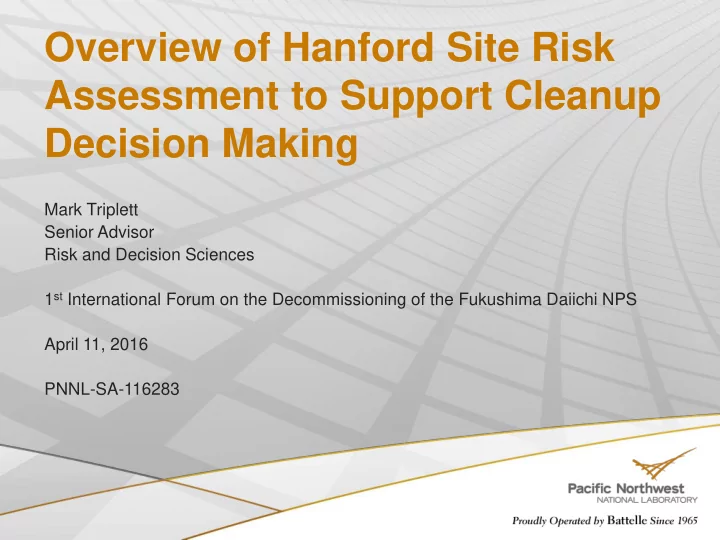

Overview of Hanford Site Risk Assessment to Support Cleanup Decision Making Mark Triplett Senior Advisor Risk and Decision Sciences 1 st International Forum on the Decommissioning of the Fukushima Daiichi NPS April 11, 2016 PNNL-SA-116283
Overview Hanford History Cleanup Mission Comparison to Fukushima Decommissioning Challenges Development of Hanford’s Risk -Informed Cleanup Strategy Risk Management Strategies Applicability to Fukushima Decommissioning – DOE/PNNL/NDF Collaboration
Plutonium Production Mission 1943 – 1989; Current Legacy 2,300 tons 106,000 tons of 9 of spent uranium processed nuclear fuel remain 74 tons of ~2,000 Capsules plutonium created 5.6 x 10 18 Bq 5 Contaminated effluents 177 tanks discharged to the 200 Million Liters ground: 1.7 x 10 12 Liters 7.2 x 10 18 Bq > 500 contaminated facilities > 2,000 waste sites PNNL-SA-115297 3 > 150 Km 2 contaminated groundwater
Plutonium Production Mission – Key Facilities PNNL-SA-115297
Hanford’s Cleanup Mission Tri-Party Agreement signed by DOE, U.S. Environmental Protection Agency and Washington state in 1989 – began the cleanup mission. Surplus facility demolition Reactor decommissioning – interim safe storage Spent fuel and nuclear material stabilization and storage Near-surface soil and debris removal and disposal Groundwater pump and treat, hydraulic control, and permeable barriers Liquid effluent processing Solid waste disposal operations Tank waste storage and treatment
Development of a Risk-Informed Strategy for the Hanford Site (1994-95) Multiple types of risk that are not directly comparable Near-term release hazards – high-consequence, low probability Workplace hazards Long-term hazards – threat to environment and public through transport of contaminants (especially contaminated groundwater transport to Columbia River) Ecosystem hazards – threat to plant and animal life Key elements of Hanford’s risk -informed strategy Promptly reduce or eliminate near-term release hazards Deactivate high-cost, high-risk legacy facilities that threaten the environment, workers, and require active, expensive surveillance and maintenance Remove waste sources close to the Columbia River Contain and remediate groundwater contamination that threatens the environment and public Shrink the footprint of active remediation and waste management activities to a small, central portion of the Site
Key Challenges and Strategies for Success Dedicated Disposal Facility Enables Hanford Cleanup and Visible Progress Future Site Uses Work Group (1992): “Use the Central Plateau Wisely for Waste Management” – Broad public consensus recognized the necessity for a dedicated waste disposal facility. ERDF (central disposal facility) built in 1995 allowed real, visible progress to occur. Today, ERDF holds more than 9 million m 3 of contaminated material. 8
Hanford Near-Term Release Hazards (1995 to Today) High-risk nuclear fuel and materials Tank safety issues Surplus reactors Processing facilities requiring active safety controls 9
Hanford Near-Term Release Hazards (1995 to Today) High-risk fuel and nuclear material moved to safe storage away from Columbia River Tank safety issues resolved Surplus reactors placed in interim safe storage (isolated from environment) Processing facilities deactivated and placed in passive safe condition 10
Long-Term Hazards – Remediation Strategy Contaminated soil removed from Active Remedies in Place for areas adjacent to Columbia River Active remedies in place for primary threats to groundwater and River Liquids removed from underground single-shell tanks 11
Risk-Informed Strategy NDF-PNNL Collaboration Risk & Inventory Release Transport Exposure (Source Term) Mechanisms Mechanisms Assessment • Initiating events • Subsurface • Workers • Fuel and fuel debris • Engineering • Airborne • Affected • Stored spent containment Environment • Ocean systems fuel (pool • Public storage) • Waste form • Contaminated release mechanisms water • Secondary waste (from water treatment) • Building debris • Environmental waste (soil and trees)
Risk-Informed Strategy Current Focus for NDF-PNNL Collaboration Risk & Inventory Release Transport Exposure (Source Term) Mechanisms Mechanisms Assessment • Initiating events • Subsurface • Workers • Fuel and fuel debris • Engineering • Airborne • Affected • Stored spent containment Environment • Ocean systems fuel (pool • Public storage) • Waste form • Contaminated release mechanisms water • Secondary waste (from • Understand existing risks associated with spent water treatment) • Building debris fuel and fuel debris • Environmental • Support evaluation of fuel debris removal waste (soil and options trees) • Evaluate changes in risk over time to inform decommissioning strategy
Thank You!
Recommend
More recommend